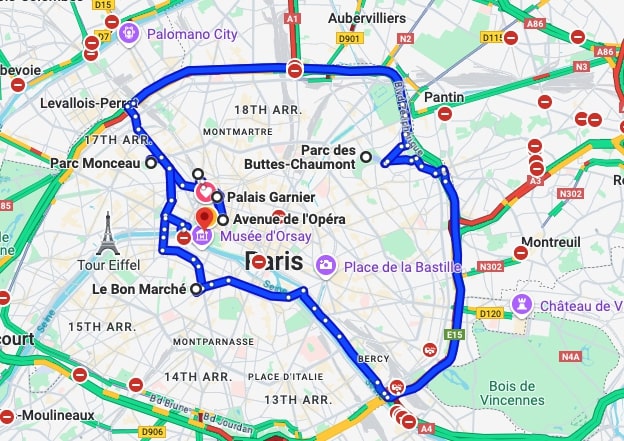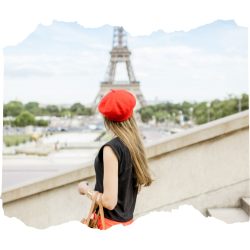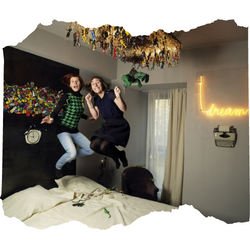Unsure about your French table manners? Click Here to download > > How to avoid these 10 food etiquette mistakes !
- Home ›
- Destinations ›
- Paris ›
- Second Empire Paris
In the Footsteps of Napoleon III: A Walk Through Second Empire Paris
Published 07 July 2025 by Leyla Alyanak — Parisian by birth, Lyonnaise by adoption, historian by passion
Much of modern Paris — the wide boulevards, public parks and harmonious façades — was built during the reign of Napoleon III. This walking itinerary traces the emperor’s lasting imprint on the city through the landmarks and green spaces he commissioned or inspired.
When visitors think of historic Paris, their minds often jump to the Middle Ages or the Belle Époque.
But much of what defines Paris today — the wide boulevards and uniform façades, the stunning train stations and wonderfully cool parks — comes straight from the reign of Napoleon III.
A nephew of Napoleon Bonaparte, or Napoleon I, Louis-Napoléon Bonaparte seized power in a coup d’état in 1851 and, after a plebiscite, declared himself Emperor the following year.
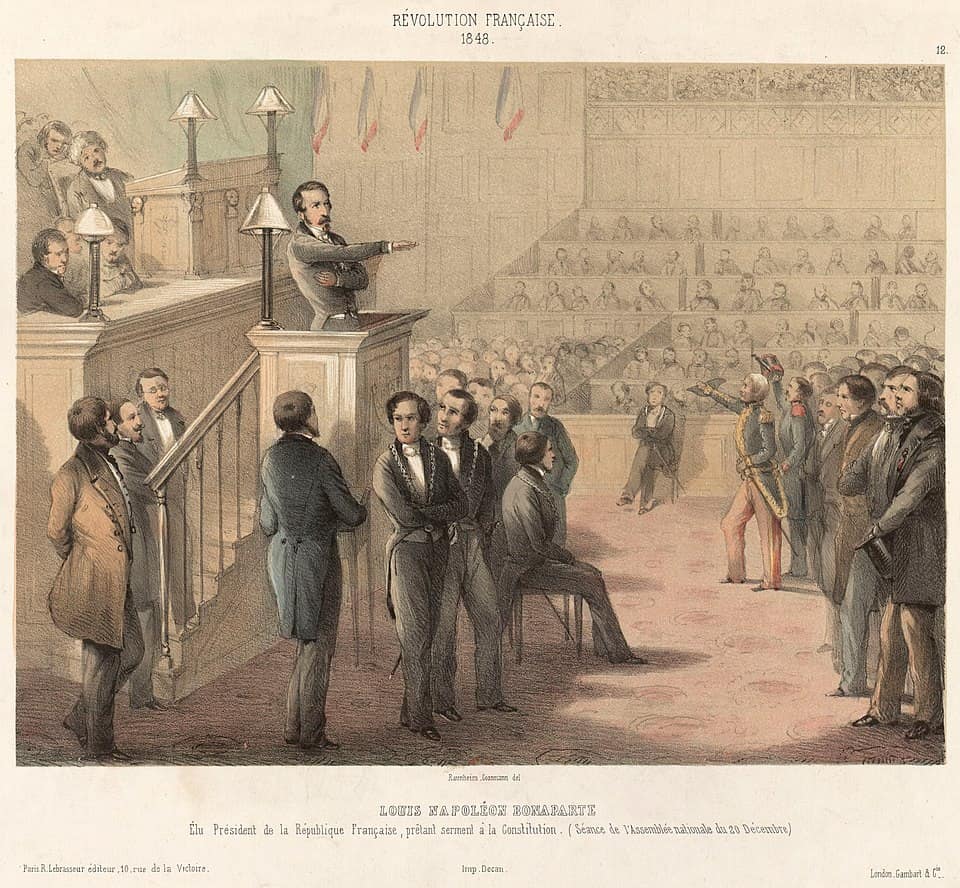 Louis-Napoleon gets sworn in as President, 1848. Artist: Raunheim-Cossmann
Louis-Napoleon gets sworn in as President, 1848. Artist: Raunheim-CossmannNOTE: Pages on this site may contain affiliate links, which support this site. See full Privacy Policy here.
If he is famous today, it is in great part because he modernized Paris, destroying old, insalubrious alleys to replace them with wide, straight avenues designed by his 'partner in crime', Baron Haussmann, his Prefect of the Seine department.
The following one-day itinerary traces the sweeping changes of the Second Empire across a Paris transformed forever by the duo.
This Second Empire itinerary is for...
- Lovers of everything Paris
- Architecture or history enthusiasts
- Anyone interested in Napoleon
- Lovers of the Belle Epoque — it came just after the Second Empire
- Flâneurs who love exploring a city on foot
And now, your Second Empire itinerary
- Start: Gare Saint-Lazare, Paris
- Walk 10 mins: Opéra Garnier, Paris
- Walk 10 mins: Avenue de l’Opéra, Paris
- Metro Line 9 (from Chaussée d’Antin–La Fayette to Monceau): Parc Monceau, Paris
- Bus 84 or Metro Line 10 (from Monceau to Sèvres-Babylone): Le Bon Marché, Paris
- Metro Line 10 to Jussieu, then Line 7bis to Buttes-Chaumont: Parc des Buttes-Chaumont, Paris
- Metro Line 7 (to Palais Royal–Musée du Louvre): Tuileries Garden, Paris
Optional Extensions:
- Galeries Lafayette
- Bois de Boulogne
- Bois de Vincennes
- Musée d’Orsay
- Gare du Nord
Main stops and sights
This walking itinerary takes you through Paris in the footsteps of Napoleon III (on foot and with the occasional metro or bus) to visit the buildings, parks, and avenues he either envisioned or inspired.
This Second Empire itinerary has seven stops, each reflecting a new 19th-century Paris.
1. Gare Saint-Lazare
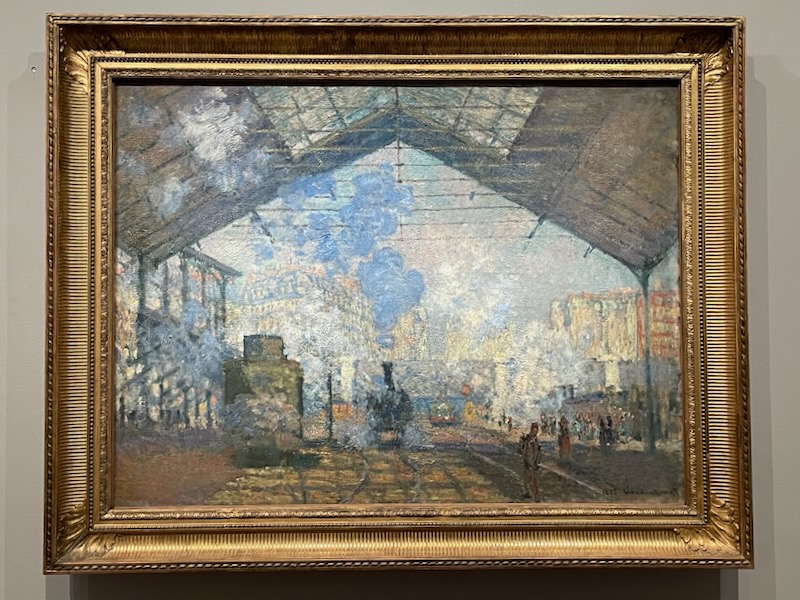 Saint-Lazare station as painted by Monet (the painting is in the Musée d'Orsay)
Saint-Lazare station as painted by Monet (the painting is in the Musée d'Orsay)Start your day at the Gare Saint-Lazare, one of the oldest railway stations in Paris and a major symbol of the Second Empire’s efforts to modernize.
Napoleon III believed that a strong railway network would transform France by bringing people and goods into the capital more quickly. This would unify distant regions and support what had become a fast-growing economy.
As Saint-Lazare linked Paris to Normandy and the Atlantic, new trade routes were opened and travel became easier for everyday people.
The building’s monumental new façade reflected the empire’s belief in progress and order, not to mention grand design.
The area around the station also changed dramatically, from a chaotic, crowded district to a much more modern space. Baron Haussmann, the emperor’s chief planner, cut new boulevards through the old neighborhood to ease traffic. Later, Claude Monet would paint the station many times...
Need your hands free to take pictures of all these wonderful French sights? I use one of these wonderful infinity scarves to store my car keys, ID and cards – no bag to carry, no backpack to hoist. Get one here.
2. Opéra Garnier
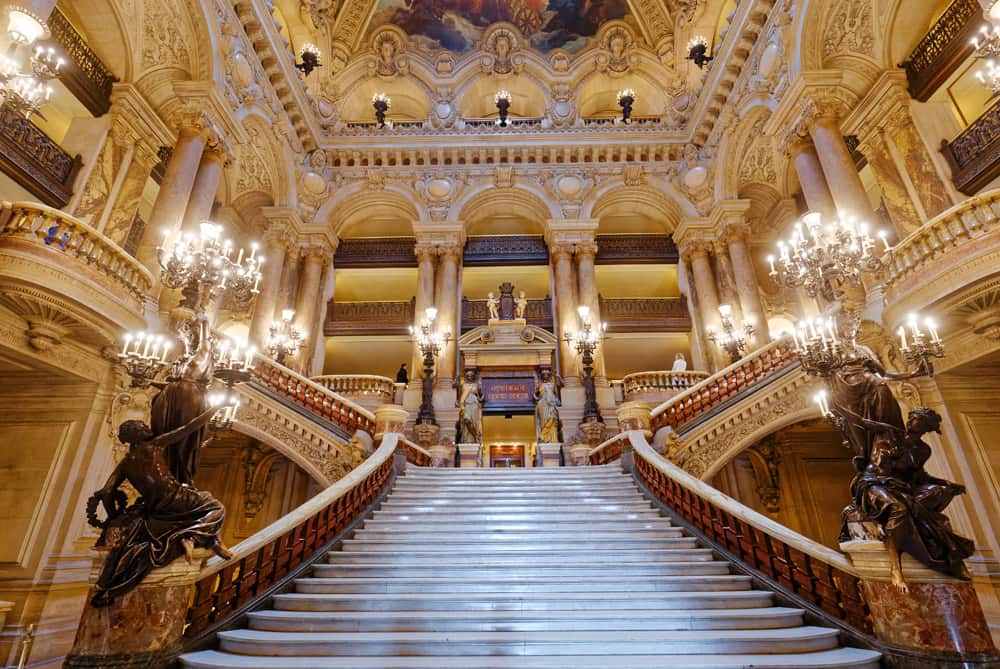 The monumental staircase of the Opéra Garnier
The monumental staircase of the Opéra GarnierThis unbelievable building was commissioned by Napoleon III and designed by Charles Garnier, and would showcase for the empire’s love of drama (theatrical, of course, but also political).
Construction began in 1861, right in the middle of the Second Empire. Napoleon III wanted a new opera house not just for entertainment, but because he also wanted to show off his regime's strength (and impress the world).
Napoleon III never saw the finished Opéra Garnier. He died in exile in 1873, three years after the empire fell, but his vision lives on in every sculpted column and chandelier.
There are tours of the Opera (here's a private one which is ideal if there are several of you) but if you're not up for a tour, at least get an entry ticket to spend time wandering up and down the grand staircase.
WHAT IS THE SECOND EMPIRE, EXACTLY?
The Second Empire lasted from 1852 to 1870 and was ruled by Louis-Napoléon Bonaparte as Emperor Napoleon III (he was Napoleon I's nephew). His rule was a mixture of authoritarianism and limited liberal reforms, but best known for ambitious urban works, modernization and the arts.
In Paris, the Second Empire reshaped the city at every level. Working with Baron Haussmann, Napoleon III cleared out overcrowded medieval neighborhoods and replaced them with wide boulevards (and parks) and with modern sewage systems. He wanted to prevent uprisings and reflect France’s status as a rising imperial power.
Much of what you'll see in Paris today — like the façades and grand avenues — can be traced directly to the Second Empire.
3. Avenue de l'Opéra
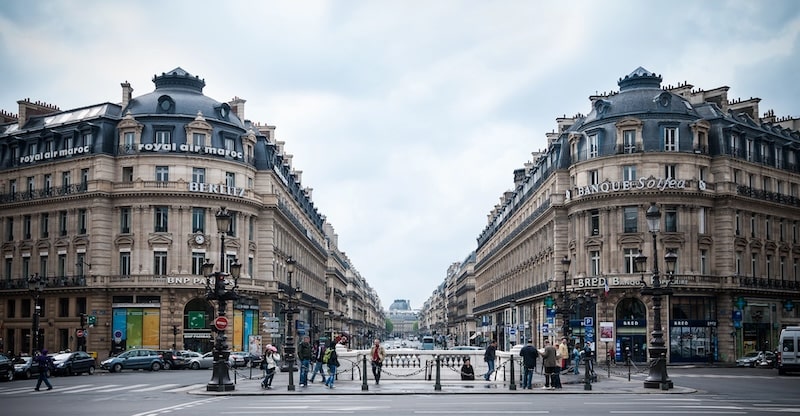 Avenue de l'Opéra, straight as an arrow
Avenue de l'Opéra, straight as an arrowWalk down Avenue de l’Opéra, one of the most visible results of Haussmann’s redesign. The boulevard was created specifically to connect the Louvre to the new Opéra in a straight line, practical for traffic, of course, but also easy to police and patrol by soldiers if there was unrest.
Before the 1850s, this area was a maze of medieval alleyways, perfect for building barricades during protests and revolutions. But Napoleon had had his share of uprisings and wanted no more.
In his new Paris, rebellions would be harder to organize (and easier to quell). He gave Haussmann the job of clearing and rebuilding entire districts, and this avenue was part of that mission.
The standard height and uniform façades along the avenue, by the way, are features which Haussmann imposed with his strict building codes. These were designed to provide order and hygiene, while guaranteeing imperial control.
4. Parc Monceau
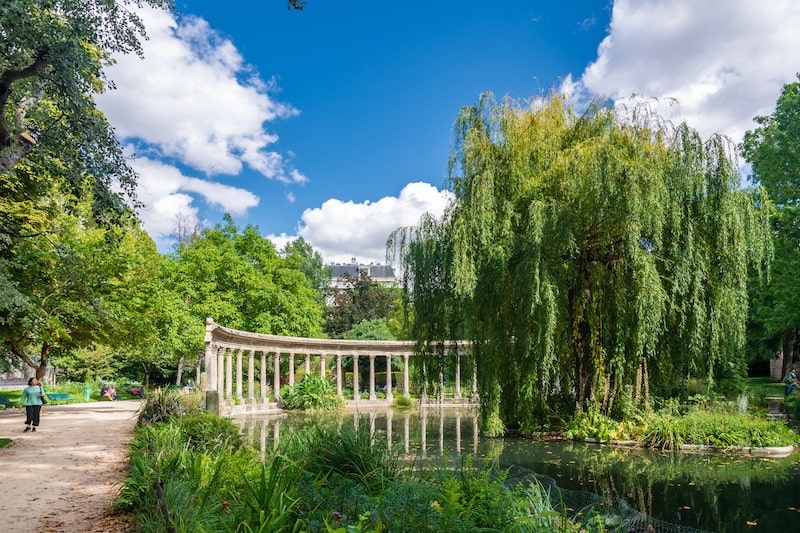
Parc Monceau is one of the most elegant and unusual parks in Paris.
Napoleon III wanted it to reflect English landscape design, which he came to admire during his exile in London. Unlike older French gardens, which followed strict, geometric lines, the new Parc Monceau was meant to feel more natural and romantic, with its winding paths and curved lawns.
It was also one of the first public parks open to all social classes, not just the wealthy or well-connected.
As you wander around, look for Corinthian columns, a miniature pyramid and faux Roman ruins, all of them whimsical touches to remind us of the theatrical side of the Second Empire. And why not bring a picnic?
Prefer using a bag or purse to carry your things? Keep pickpockets at bay with one of these GO Anti-theft cross-body bags (I have three, in different colors and models). Browse the different models and colors here.
5. Au Bon Marché
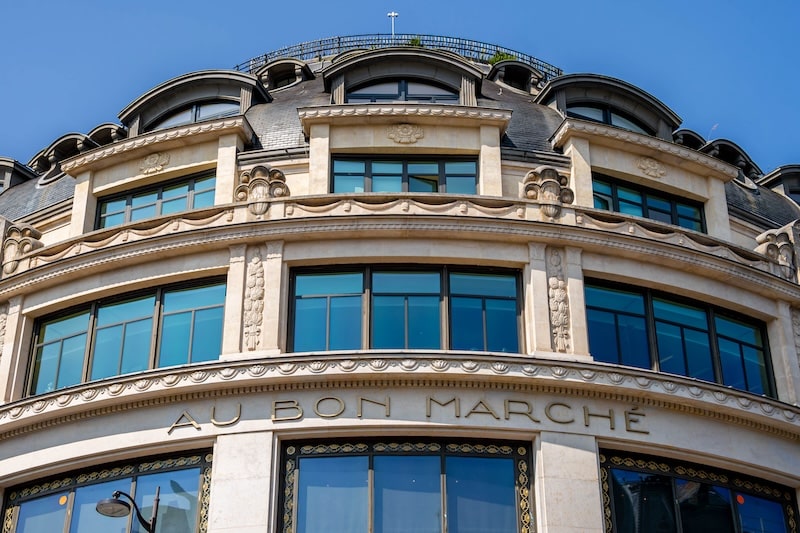
Au Bon Marché opened in 1852, one of the world’s first true department stores. It changed the way Parisians shopped by offering fixed prices and plenty of choice, and made it easier to return unwanted goods – a whole new retail experience.
It grew (it was massively expanded in the 1860s) in tandem with Napoleon III’s efforts to modernize the economy and encourage a consumer culture – this was his vision for an energized and dynamic urban France.
Also, the building’s use of cast iron and glass reflected the era’s fascination with industrial elegance, just when everything was changing quickly. We can see the embrace of industrial beauty and cutting-edge materials, all part of the new, progressive (but well-ordered) Paris.
6. Parc des Buttes-Chaumont
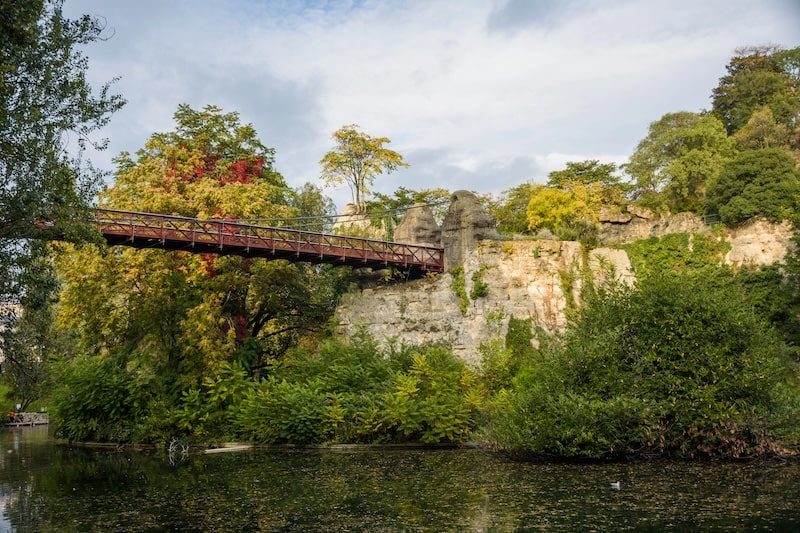
In the mid-19th century, this site was a polluted quarry and dumping ground. Napoleon III, determined to turn Paris into a healthier and more beautiful city, ordered it transformed into a public park.
It was designed by engineer Jean-Charles Alphand and when it opened in 1867 for the Exposition Universelle, it created awe and delight, with its steep cliffs, a suspension bridge, waterfalls, and even a miniature Roman temple perched high above a manmade lake.
The result may feel a bit theatrical, but that was the point. The Second Empire loved a good spectacle, and parks like this gave working Parisians a sense of wonder about their own city. Gustave Eiffel, still early in his career, designed the park’s iron bridge decades before he became famous for the tower that bears his name.
7. Jardin des Tuileries

End your day in the Tuileries Garden, once the front yard of the imperial Tuileries Palace. This was Napoleon III’s main residence in Paris until it was burned down during the violence of the Paris Commune in 1871, shortly after the fall of the Second Empire.
Though the palace is gone, the garden layout is still pretty much the same. It was originally designed by André Le Nôtre in the 17th century but Napoleon III turned it into a promenade, opening up its green spaces to everyone as part of his urban reforms.
The garden was a symbol of Second Empire Paris. Physically, it stands between the Louvre and Place de la Concorde, and symbolically, it occupies the space between the old monarchy and the new imperial order.
Additional optional stops
- Bois de Boulogne and Bois de Vincennes: Both created under Napoleon III to give Parisians access to nature.
- Musée d’Orsay: For portraits of Empress Eugénie by Winterhalter and works by painters active during the Second Empire.
- Gare du Nord: Another major station expanded under Napoleon III, now a major European hub.
Before you go...
While it may be a challenge to get our heads around this, we should remember that Second Empire Paris was not designed to look old, but to feel new. Keep this in mind as you walk through its world.
You'll actually be surrounded by a version of modernity imagined by an emperor who failed at many things, but whose greatest legacy may be the capital city he left behind.
More Paris stories? You'll find them here.
Did you enjoy this article? I'd love if you shared it!
